|
15. For the three product categories, respondents indicated that
the following information is important, and they would like to locate
it easily:
- Directions for use,
- Description of what the product does,
- Description of where not to use the product,
- Information about effects on personal and children's health
(except for cleaners users), and
- Emergency information.
Table 2-10: What Information Found on the Packaging of Products Is Most Important to You?
| Indoor Insecticide |
Household Cleaner |
Outdoor Pesticide |
| Directions on how to use the product
80% |
Directions on how to use the product
83% |
Directions on how to use the product
85% |
| Description of what the product
does 69% |
Description of what the product
does 72% |
Description of what the product
does 73% |
| Information about effects on personal
and children's health or safety 49% |
Information about where the product
should not be used 52% |
Information about effects on personal
and children's health or safety 48% |
| Information on what to do in an
emergency or in case of an accident 45% |
Brand Name 49% |
Information about where the product
should not be used 46% |
| Information about where the product
should not be used 42% |
Information on what to do in an
emergency or in case of an accident 48% |
Information on what to do in an
emergency or in case of an accident 35% |
(Base = All Respondents)
16. In all three product categories,
respondents always indicated that the least important information
to them on current labels was the positive environmental claims
statements (e.g., contains no CFCs, contains no phosphates) and
the name of the manufacturer. In all three product categories, respondents
ranked label information about disposal, storage, ingredients, and
a consumer information phone number as the least important.
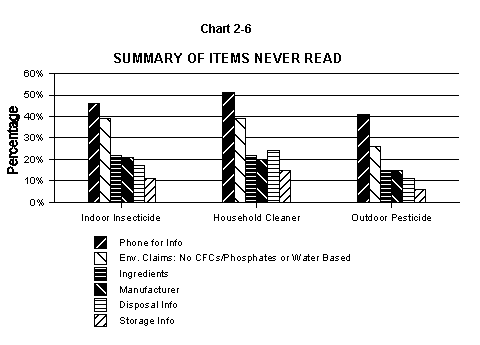
Table 2-11: Summary of Items Never Read (%)
| |
Indoor Insecticide |
Household Cleaner |
Outdoor Pesticide |
| Phone for Info |
46 |
51 |
41 |
| Positive Environmental Claims:
No CFCs/ Phosphates or Water Based |
39 |
39 |
26 |
| Ingredients |
22 |
22 |
15 |
| Manufacturer |
21 |
20 |
15 |
| Disposal Info |
17 |
24 |
11 |
| Storage Info |
11 |
15 |
6 |
(Base = All Respondents)
17. For outdoor pesticides and indoor insecticides, respondents
consistently indicated that they do not read or give importance
to statements on environmental claims (e.g., contains no CFCs).
18. In all three product categories, there is a similarity between
the label information perceived to be the most important and the
information that respondents indicated that they wish to find most
easily. The top three (in order of preference) are: (1) directions
for use, (2) a description of what the product does, and (3) precautionary
statements related to human health (please see Table 2-10).
Table 2-12: What Information Do You Want to Be Able to Find Most Easily?
| Indoor Insecticide |
Household Cleaner |
Outdoor Pesticide |
| Directions on how to use the product
69% |
Directions on how to use the product
72% |
Directions on how to use the product
76% |
| Description of what the product
does 57% |
Description of what the product
does 61% |
Description of what the product
does 63% |
| Information on what to do in an
emergency or in case of an accident 47% |
Information on what to do in an
emergency or in case of an accident 49% |
Information about where the product
should not be used 44% |
| Information about effects on personal
and children's health or safety 43% |
Information about where the product
should not be used 44% |
Information about effects on personal
and children's health or safety 43% |
| Information about where the product
should not be used 36% |
Information about effects on personal
and children's health or safety 39% |
Information on what to do in an
emergency or in case of an accident 41% |
(Base = All Respondents)
Table 2-13: When Deciding Which Product to Purchase, Which of the Following Types of Information, If Any, Do You Look for?
| Indoor Insecticide |
Household Cleaner |
Outdoor Pesticide |
| Product characteristics, such
as non-staining, non-corrosive, won't scratch surface, low odor,
etc. 63% |
Product characteristics, such
as non-staining, non-corrosive, won't scratch surface, low odor,
etc. 81% |
Will not harm wildlife, pets,
fish 52% |
| Will not harm wildlife, pets,
fish 56% |
Non-flammable 44% |
Low potential for harming plants
49% |
| Non-flammable 42% |
Container or packaging characteristics
23% |
Low potential for contaminating
ground water 48% |
| Low potential for harming plants
41% |
No phosphates 17% |
Packaging allows for reduced contact
with the product 40% |
| Packaging allows for reduced contact
with the product 33% |
No CFCs 13% |
Non-flammable 36% |
(Base = All Respondents)
|
Implications Regarding Respondents'
Hierarchy of Importance of Information on Product Labels
A. Consumers regularly looked for the information that they
regard as important: the product purpose and personal precautionary
information.
B. People want to be able to find information they regard
as important quickly. Any modifications of the label should
allow this information to be easily identifiable.
C. Respondents were less concerned about label information
relating to storage and environmental issues,
including disposal information, environmental claims, and
environmental effects.
|
Findings on Label Format (Chart
2-7, Table 2-14)
19. After being given a description of different formats, respondents
in all three product categories preferred a box format on the label,
like the nutrition facts box, that presents information consistently
among products in the same category.
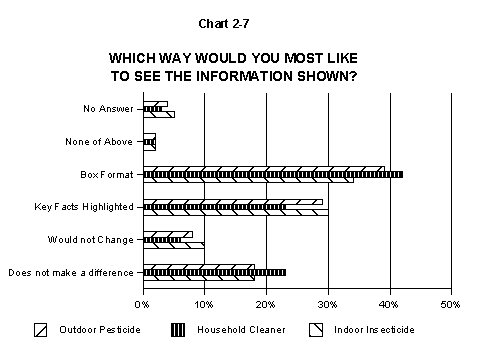
Table 2-14: Which Way Would You Most Like to See The Information Shown? (%)
| |
Does not make a difference
|
Would
not Change |
Key
Facts High-lighted |
Box
Format |
None
of Above |
No
Answer |
| Outdoor Pesticide n=846 |
18 |
8 |
29 |
39 |
2 |
4 |
| Household Cleaner n=894 |
23 |
6 |
23 |
42 |
2 |
3 |
| Indoor Insecticide n=889 |
18 |
10 |
30 |
34 |
2 |
5 |
(Base = All Respondents)
|
Implications Regarding Label
Format
A. Label comprehension can be
improved by using standard formats.
B. Ease of use encourages more
frequent label reading.
|
Findings on Respondents' Preference for
FIFRA versus Non-FIFRA Product Labels (Chart 2-8, Chart
2-9)(1)
20. Over half of the respondents in
the household cleaner category preferred the FIFRA label (the type
of label appearing on EPA registered products), including the overall
label and the subparts on directions for use, where the product
should not be used, effects on personal health, ingredients, storage,
disposal, and emergency information, over the non-FIFRA label (labels
appearing on non-registered, but similar, products).

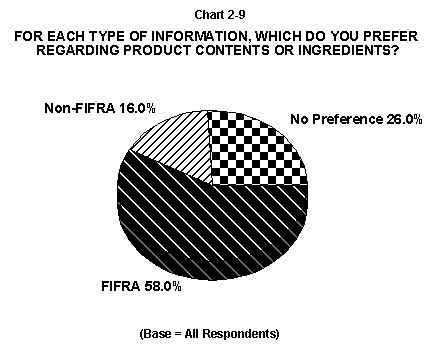
|
Implications Regarding Respondents' Preferability
for FIFRA versus Non-FIFRA Product Labels
A. Consumers desire specific types of information to appear
on the product label.
|
Findings on Storage and Disposal Information
(Chart 2-10, Chart 2-11, Chart 2-12, Table 2-15, Table 2-16,
Table 2-17)
21. Outdoor pesticide and indoor insecticide users read the storage
and disposal information significantly more than household cleaner
respondents.
22. The most frequent reasons given for not reading storage and
disposal information in the store was that it is "information they
already know," followed by "just don't read it."
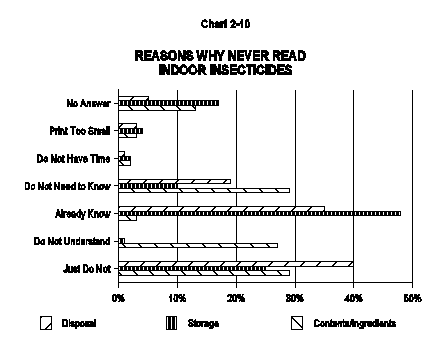
Table 2-15: Reasons Why Never Read Indoor Insecticides (%)
| |
Just Do Not
|
Do
Not Understand |
Already
Know |
Do
Not Need to Know |
Do
Not Have Time |
Print
Too Small |
No
Answer |
| Disposal (150) |
40 |
0 |
35 |
19 |
1 |
3 |
5 |
| Storage (102) |
25 |
1 |
48 |
10 |
2 |
4 |
17 |
Contents/
Ingredients (200) |
29 |
27 |
3 |
29 |
2 |
3 |
13 |
(Base
= All Indoor Pesticide Respondents Who Said They Never Read
Storage & Disposal, and Ingredients Information, Out of
a Total of 889 Indoor Pesticide Respondents)

Table 2-16: Reasons Why Never Read Household Cleaner (%)
| |
Just Do Not
|
Do
Not Understand |
Already
Know |
Do
Not Need to Know |
Do
Not Have Time |
Print
Too Small |
No
Answer |
| Disposal (216) |
38 |
0 |
32 |
19 |
3 |
4 |
9 |
| Storage (131) |
21 |
1 |
39 |
20 |
6 |
3 |
15 |
Contents/
Ingredients (201) |
31 |
15 |
10 |
31 |
4 |
3 |
11 |
(Base
= All Household Cleaner Respondents Who Said They Never Read
Storage & Disposal, and Ingredients Information, Out of
a Total of 894 Household Cleaner Respondents)
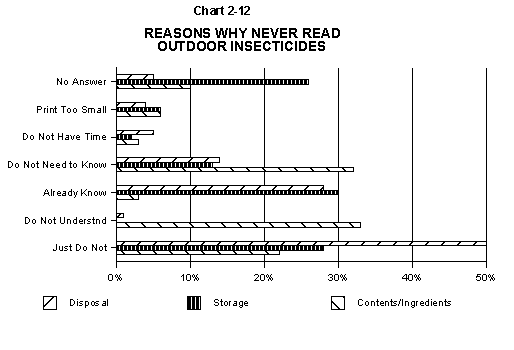
Table 2-17: Reasons Why Never Read Outdoor Insecticides (%)
| |
Just Do Not |
Do
Not Understand |
Already
Know |
Do
Not Need to Know |
Do
Not Have Time |
Print
Too Small |
No
Answer |
| Disposal (93) |
50 |
1 |
28 |
14 |
5 |
4 |
5 |
| Storage (54) |
28 |
0 |
30 |
13 |
2 |
6 |
26 |
Contents/
Ingredients (127) |
22 |
33 |
3 |
32 |
3 |
6 |
10 |
(Base = All
Outdoor Pesticide Respondents Who Said They Never Read Storage
& Disposal, and Ingredients Information,
Out of a Total of 846 Outdoor Pesticide Respondents )
23. The following represents the findings of an "open-ended" question
regarding methods of disposal:(2)
- In all three categories, most respondents disposed of pesticides
and cleaner products or packages in the trash;
- Household cleaner users recycled more frequently than those
responding in the indoor and outdoor product categories;
- One in ten outdoor pesticide users disposed through special
collections, which is more than users of indoor insecticides and
cleaners;
- Less than 10% overall used special collections;
- Cleaner users found it acceptable to dispose of products/residues
down the drain;
- Few users indicated that they disposed of products down the
drain or diluted and used them up; and
- Virtually no consumers said they call the city or county for
disposal advice;
24. There were no significant differences in responses from respondents
in the states with strong household hazardous waste programs, versus
those respondents from states that do not have strong household
hazardous wastes programs.
|
Implications Regarding Storage
and Disposal Information
A. Storage and disposal issues are of low priority and are
not important to consumers.
|
Findings on Recycling Claims and
Symbols (Chart 2-13, Table 2-18)
25. A high percentage of survey participants responded either "Not
really sure" or gave an incorrect response for every question under
each symbol. This was true even allowing for local recycling programs
that might make some answers correct for panelists in those localities.
1. Non-FIFRA labels do not
exist for the indoor insecticides and outdoor pesticides product
categories.
2. It is not known whether
respondents were referring to the disposal of containers, unused
product, or both.
[Go to next section]
|
![[logo] US EPA](../gif/logo_epaseal.gif)






